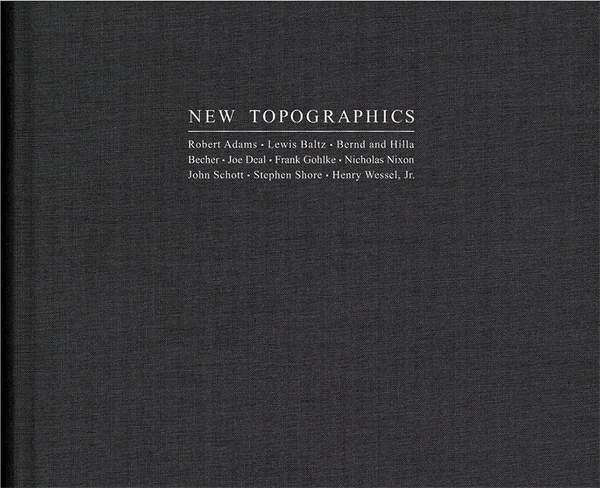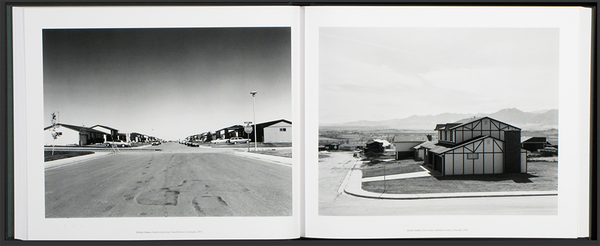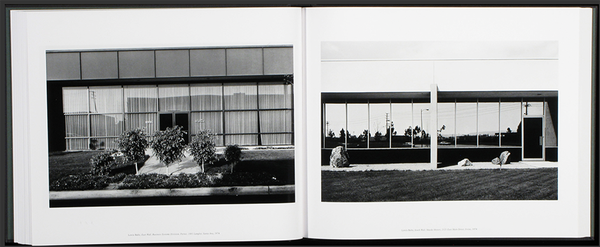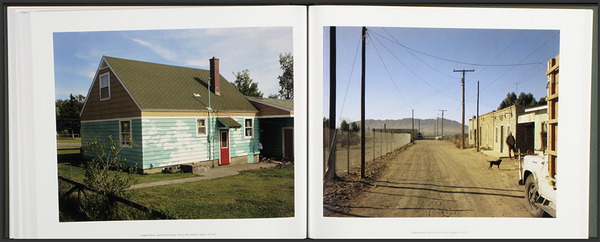Robert Adams, Lewis Baltz, Bernd and Hilla Becher, Joe Deal, Frank Gohlke, Nicholas Nixon, John Schott, Stephen Shore, Henry Wessel Jr.
New Topographics
Steidl, Gottingen, DE, 2009
Britt Salvesen, Anthony Bannon
pages 304
dimensions 24.5 × 29.5 cm, hardcover
language English
ISBN 978-3-86521-827-8
pages 304
dimensions 24.5 × 29.5 cm, hardcover
language English
ISBN 978-3-86521-827-8

ARTISTS
IMAGES
Robert Adams
American photographer who has focused on the changing landscape of the American West recording there, in over fifty books. His work first came to prominence in the mid-1970s through his book The New West (1974) and his participation in the exhibition New Topographics: Photographs of a Man-Altered Landscape in 1975. He has received two Guggenheim Fellowships, a MacArthur Fellowship, the Deutsche Börse Photography Prize and the Hasselblad Award. He lives with his wife Kerstin in Astoria, Oregon, United States of America.
American photographer who has focused on the changing landscape of the American West recording there, in over fifty books. His work first came to prominence in the mid-1970s through his book The New West (1974) and his participation in the exhibition New Topographics: Photographs of a Man-Altered Landscape in 1975. He has received two Guggenheim Fellowships, a MacArthur Fellowship, the Deutsche Börse Photography Prize and the Hasselblad Award. He lives with his wife Kerstin in Astoria, Oregon, United States of America.
Lewis Baltz
He studied at the San Francisco Art Institute, and received an MFA from the Claremont Graduate School in 1971. He worked as a freelance photographer in California and taught photography at various institutions. His work has been included in major exhibitions, including New Topographics at the George Eastman House in 1975. He produced photographs in series focused on a particular theme or geographic area and usually published them in book form.
He studied at the San Francisco Art Institute, and received an MFA from the Claremont Graduate School in 1971. He worked as a freelance photographer in California and taught photography at various institutions. His work has been included in major exhibitions, including New Topographics at the George Eastman House in 1975. He produced photographs in series focused on a particular theme or geographic area and usually published them in book form.
Bernd & Hilla Becher
Bernhard Becher (20.08.1931 Siegen, Germany - 2.06.2007, Rostock, Germany), known as Bernd studied painting at the Stuttgart Academy of Fine Arts from 1953 to 1956 and then turned to printmaking with Austrian Karl Rössing at the Düsseldorf Academy. His family had for generations worked in industry in the Ruhr area, which, however, just in the 1950s began to downsize. Bernd then decided to devote himself to illustrations concerning the family's working environment. In 1957 he photographed a mine that was to be decommissioned so that he could use the photos as working material; as a result of this experience, he realized that he had an interest in photography. At the Academy, he met student Hilla Wobeser, who taught him photography, and together they made their first photographic reportage in the Ruhr region. Hilla Wobeser (2.09.1934 Potsdam, Germany – 10.10.2015 Düsseldorf, Germany) became interested in photography at a young age thanks to her mother and uncle, both professional photographers. In 1951 she became an apprentice to Walter Eichgrun, a well-known photographer, and at the same time attended, as her mother had already done, photography school at the Lette-Verein in Berlin. While working with Eichgrun, Hilla performs several freelance assignments and shows a strong interest in industrial photography. She becomes a professional photographer in 1954. In 1957 she moves to Hamburg and enrolls at the Düsseldorf Academy, where she meets painting student Bernd Becher. In 1961 they married and began working as photographers for the Troost advertising agency in Düsseldorf.
Bernhard Becher (20.08.1931 Siegen, Germany - 2.06.2007, Rostock, Germany), known as Bernd studied painting at the Stuttgart Academy of Fine Arts from 1953 to 1956 and then turned to printmaking with Austrian Karl Rössing at the Düsseldorf Academy. His family had for generations worked in industry in the Ruhr area, which, however, just in the 1950s began to downsize. Bernd then decided to devote himself to illustrations concerning the family's working environment. In 1957 he photographed a mine that was to be decommissioned so that he could use the photos as working material; as a result of this experience, he realized that he had an interest in photography. At the Academy, he met student Hilla Wobeser, who taught him photography, and together they made their first photographic reportage in the Ruhr region. Hilla Wobeser (2.09.1934 Potsdam, Germany – 10.10.2015 Düsseldorf, Germany) became interested in photography at a young age thanks to her mother and uncle, both professional photographers. In 1951 she became an apprentice to Walter Eichgrun, a well-known photographer, and at the same time attended, as her mother had already done, photography school at the Lette-Verein in Berlin. While working with Eichgrun, Hilla performs several freelance assignments and shows a strong interest in industrial photography. She becomes a professional photographer in 1954. In 1957 she moves to Hamburg and enrolls at the Düsseldorf Academy, where she meets painting student Bernd Becher. In 1961 they married and began working as photographers for the Troost advertising agency in Düsseldorf.
Frank Gohlke
Frank Gohlke is an American landscape photographer. He has been awarded two Guggenheim fellowships, two fellowships from the National Endowment for the Arts, and a Fulbright Scholar Grant. Gohlke was one of ten photographers selected to be part of "New Topographics: Photographs of a Man-Altered Landscape," the landmark 1975 exhibition at the International Museum of Photography at George Eastman House.
Frank Gohlke is an American landscape photographer. He has been awarded two Guggenheim fellowships, two fellowships from the National Endowment for the Arts, and a Fulbright Scholar Grant. Gohlke was one of ten photographers selected to be part of "New Topographics: Photographs of a Man-Altered Landscape," the landmark 1975 exhibition at the International Museum of Photography at George Eastman House.
Nicholas Nixon
Known for his work in portraiture and documentary photography. He preferred working with large-format because it allowed prints to be made directly from negatives. In 1975 he began the project The Brown Sisters, consisting of a single portrait of his wife and her three sisters each year, consistently posed in the same left to right order.
Known for his work in portraiture and documentary photography. He preferred working with large-format because it allowed prints to be made directly from negatives. In 1975 he began the project The Brown Sisters, consisting of a single portrait of his wife and her three sisters each year, consistently posed in the same left to right order.
Henry Wessel
Wessel came to photography almost accidentally during his years at Pennsylvania State University, but he was immediately hooked. He began to photograph seriously in 1967, inspired by the work of Wright Morris, Robert Frank, and Garry Winogrand, and in 1971 he was awarded a Guggenheim grant to document the landscape that flanks the American highway system, a once-natural terrain profoundly transformed by human presence. In the 1970s, Wessel became part of a generation of artists who challenged and expanded the categories of landscape and documentary photography, foregoing traditional views of pristine nature in favor of straightforward and personal depictions of the built environment.
Wessel came to photography almost accidentally during his years at Pennsylvania State University, but he was immediately hooked. He began to photograph seriously in 1967, inspired by the work of Wright Morris, Robert Frank, and Garry Winogrand, and in 1971 he was awarded a Guggenheim grant to document the landscape that flanks the American highway system, a once-natural terrain profoundly transformed by human presence. In the 1970s, Wessel became part of a generation of artists who challenged and expanded the categories of landscape and documentary photography, foregoing traditional views of pristine nature in favor of straightforward and personal depictions of the built environment.







